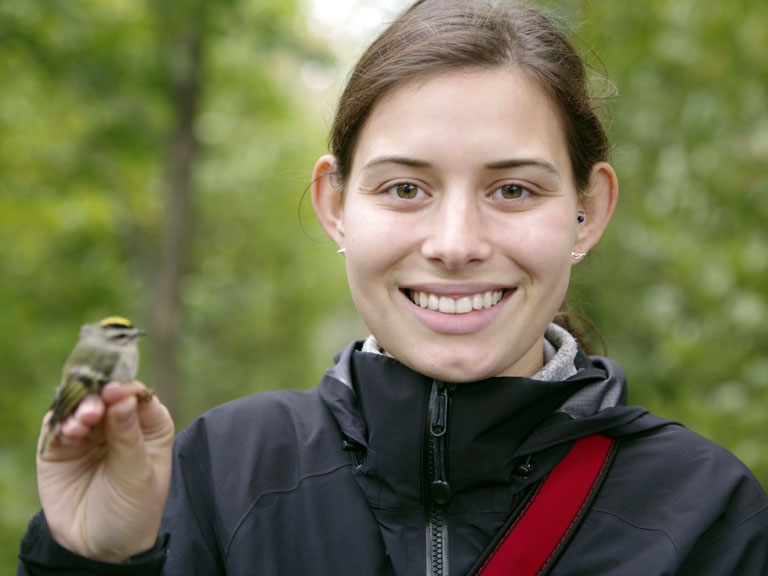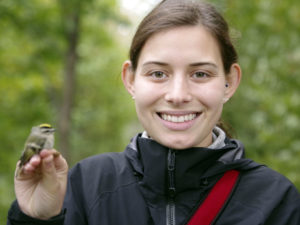County News
Southward bound

Fall migration monitoring program at bird observatory

Assistant bander Shae Turner holds a golden crowned kinglet before its release.
In the thin light of dawn the bird banders in residence at the Prince Edward Point Bird Observatory (PEPtBO) unfurl a series of near-invisible nets used to capture migrating birds as they make their way from the northern boreal forests to their wintering grounds in Central and South America. Depending on wind and rain, the nets can remain in place for up to six hours a day during the migration season from September 1 to October 31. Tens of thousands of birds fly across this part of the County, pausing briefly to fuel up for the trip across the lake and then on to their eventual destination. Some of those birds become trapped in the nets, and they are carefully extricated and brought over to the banding station, where volunteers record the type of species, age and physical condition. A tiny numbered metal band is fastened to one of the birds’ legs before they are released to continue on their journey. The birds suffer no harm during this process. Many are quite docile, although some, such as the feisty chickadee, make their annoyance known.
The banding project at PEPtBO is led by David Okines, with two assistant banders in residence as well as a number of local volunteers. The monitoring program has a very high reputation and attracts interest from across the world. Assistant bander Alan Ross is from Florida, and makes his career by participating in banding projects across the United States, as well as the Caribbean, and now Canada.
The second assistant bander is Shae Turner, who hails from Vancouver and is on her first visit to Ontario. She became interested in birds and their habitat while taking part in a behavioural study of tree swallows, and this is her first major bird project after graduating with a science degree. During her time at PEPtBO she has so far banded over 1,500 birds comprising 60 different species, almost all of them new to her. “This bird observatory in particular is really good for getting the experience and David [Okines] is really good about getting the assistants to band a lot of birds and learn a lot of new things,” she says. “We’re monitoring populations of species. The important thing now, with climate change and deforestation, the habitat in the boreal forest is being affected, so we could be seeing smaller population sizes coming from there. The long-term monitoring and data is important to help us conserve bird habitat and species.” Her favourite species at the observatory has been the blue jay. “Everyone thinks that is funny, but we don’t have them in BC and I was really excited to see them.”
The fall migration is in its final weeks, and there are an increasing number of far north denizens showing up in the nets. Species such as the ruby or golden crowned kinglets are among the first to pass through in the spring on their way north, and are among the last to pass through on their way south in the fall. These hardy little birds are a bit more cold-tolerant than their larger cousins, and their remarkable migration spans over thousands of kilometres. Not bad for a creature that tips the scale at a little under a quarter of an ounce when it’s well-fed.

Comments (0)